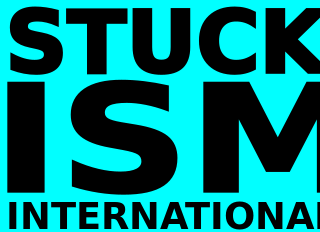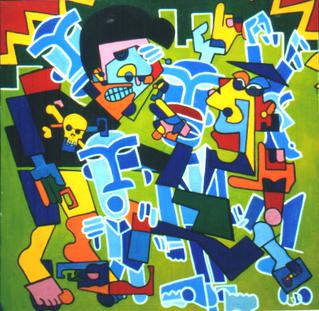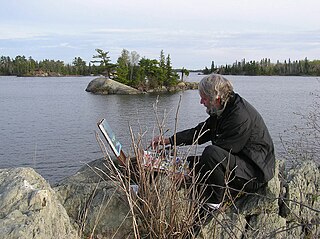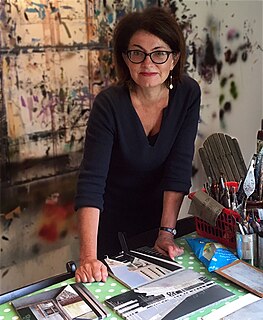
Stuckism is an international art movement founded in 1999 by Billy Childish and Charles Thomson to promote figurative painting as opposed to conceptual art. By May 2017 the initial group of 13 British artists had expanded to 236 groups in 52 countries.

Bridget Louise Riley is an English painter known for her op art paintings. She lives and works in London, Cornwall and the Vaucluse in France.
John Walker is an English painter and printmaker. He has been called "one of the standout abstract painters of the last 50 years."

Gillian Ayres was an English painter. She is best known for abstract painting and printmaking using vibrant colours, which earned her a Turner Prize nomination.

Damien Steven Hirst is an English artist, entrepreneur, and art collector. He is one of the Young British Artists (YBAs) who dominated the art scene in the UK during the 1990s. He is reportedly the United Kingdom's richest living artist, with his wealth estimated at $384 million in the 2020 Sunday Times Rich List. During the 1990s his career was closely linked with the collector Charles Saatchi, but increasing frictions came to a head in 2003 and the relationship ended.

Australian art is any art made in or about Australia, or by Australians overseas, from prehistoric times to the present. This includes Aboriginal, Colonial, Landscape, Atelier, early-twentieth-century painters, print makers, photographers, and sculptors influenced by European modernism, Contemporary art. The visual arts have a long history in Australia, with evidence of Aboriginal art dating back at least 30,000 years. Australia has produced many notable artists of both Western and Indigenous Australian schools, including the late-19th-century Heidelberg School plein air painters, the Antipodeans, the Central Australian Hermannsburg School watercolourists, the Western Desert Art Movement and coeval examples of well-known High modernism and Postmodern art.

The Saatchi Gallery is a London gallery for contemporary art and an independent charity opened by Charles Saatchi in 1985. Exhibitions which drew upon the collection of Charles Saatchi, starting with US artists and minimalism, moving to the Damien Hirst-led Young British Artists, followed by shows purely of painting, led to Saatchi Gallery becoming a recognised authority in contemporary art globally. It has occupied different premises, first in North London, then the South Bank by the River Thames, and finally in Chelsea, Duke of York's HQ, its current location. In 2019 Saatchi Gallery became a registered charity and begun a new chapter in its history. Recent exhibitions include the major solo exhibition of the artist JR, JR: Chronicles, and London Grads Now in September 2019 lending the gallery spaces to graduates from leading fine art schools who experienced the cancellation of physical degree shows due to the pandemic.
Jack Vettriano is a Scottish painter. His 1992 painting The Singing Butler became a best-selling image in Britain.

Stuckism is an art movement that began in London, England, in 1999. In 2000, Melbourne artist Regan Tamanui started the first international branch of the movement. As of 2010, there are seven Australian Stuckist groups, who have held shows—sometimes concurrently with UK activities—received coverage in the Australian press and on TV, and also been represented in UK shows. The Stuckists take a strong pro-painting and anti-conceptual art stance, and were co-founded by Charles Thomson and Billy Childish.
Euan Ernest Richard Uglow was a British painter. He is best known for his nude and still life paintings, such as German Girl and Skull.

Norman Wilkinson was a British artist who usually worked in oils, watercolours and drypoint. He was primarily a marine painter, but also an illustrator, poster artist, and wartime camoufleur. Wilkinson invented dazzle painting to protect merchant shipping during the First World War.

Robert Douglas Genn was a Canadian artist, who gained recognition for his style, which is in the tradition of Canadian landscape painting. He ran a painters' website, which sends out twice weekly newsletters to 135,000 artists. In 2005, Genn campaigned against the Chinese website, arch-world.com, which was selling thousands of high-resolution images of around 2,800 artists' work illegally, without permission. He succeeded to an extent.

Adam Neate is a British painter, conceptual artist and described by The Telegraph in 2008 as "one of the world's best-known street artists". He specialised in painting urban art on recycled cardboard, and has left thousands of works in the street for anyone to collect. He is a contributor from the movement in transferring street art into galleries. Neate's street art has garnered global interest, having been documented on CNN reports and European television. Major collectors and celebrities are fighting for his original works and international critics have lauded the artist's work. Since 2011 Neate has been mastering his own language of 'Dimensional Painting'. Elms Lesters publish a range of Adam Neate's Dimensional Editions and Multiples

Makinti Napanangka was a Pintupi-speaking Indigenous Australian artist from Australia's Western Desert region. She was referred to posthumously as Kumentje. The term Kumentje was used instead of her personal name as it is customary among many indigenous communities not to refer to deceased people by their original given names for some time after their deaths. She lived in the communities of Haasts Bluff, Papunya, and later at Kintore, about 50 kilometres (31 mi) north-east of the Lake MacDonald region where she was born, on the border of the Northern Territory and Western Australia.
Shani Rhys James MBE is a Welsh painter based in Llangadfan, Powys. She has been described as "arguably one of the most exciting and successful painters of her generation" and "one of Wales’ most significant living artists". She was elected to the Royal Cambrian Academy of Art in 1994. In the 2006 New Years Honours she was appointed Member of the Order of the British Empire (MBE) for "services to art".
June Yvonne Mendoza, AO, OBE, RP, ROI, HonSWA is an Australian portrait painter, working mainly in oil.
The year 2015 in art involves various significant events.
Aida Tomescu is a Romanian and Australian contemporary artist who is known for her abstract paintings, collages, drawings and prints. Tomescu is a winner of the Dobell Prize for Drawing, the Wynne Prize for Landscape and the Sir John Sulman Prize, by the Art Gallery of New South Wales.

Mandy Payne is a member of the Contemporary British Painting group and is an artist with a primary interest in portraying the regeneration of inner city environments and the transitory nature of urban communities. Her themes include the contrasts between twentieth century inner-city social housing and modern gentrification.
Mandy Martin was a well-known contemporary Australian painter, printmaker and teacher. She was involved in the development of feminist art in Australia from the mid-1970s and as exhibited widely in Australia and internationally. In later recent years she used the art she created as part of the ongoing debate on climate change, an area in which she was "prolifically active". Based in Canberra for many years, she was also a lecturer at the ANU School of Art from 1978 to 2003. As well as being a visual artist, Martin was an adjunct professor at the Fenner School of Environment and Society at the Australian National University.











